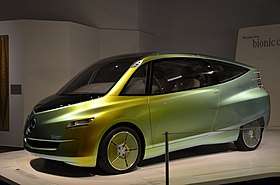Mercedes-Benz Bionic
The Mercedes-Benz Bionic was a concept car created by DaimlerChrysler AG under the Mercedes Group. It was first introduced in 2005 at the DaimlerChrysler Innovation Symposium in Washington, D. C. The Bionic was modeled after a type of fish, the yellow boxfish, Ostracion cubicus,[1] and also has 80% lower nitrogen oxide emissions with its selective catalytic reduction technology.
| Mercedes-Benz Bionic | |
|---|---|
 | |
| Overview | |
| Manufacturer | Mercedes-Benz |
| Production | Concept car (2005) |
| Powertrain | |
| Engine | 1.9-liter four-cylinder direct-injection turbodiesel. 138 hp (103 kW) |
| Transmission | Autotronic CVT transmission |
| Dimensions | |
| Wheelbase | 101 in (2,565 mm) |
| Length | 167 in (4,242 mm) |
| Width | 71.5 in (1,816 mm) |
| Height | 62.8 in (1,595 mm) |
| Curb weight | 2,425 lb (1,100 kg) |

_02.jpg)
Engine and performance
The Bionic is powered by a 103 kW direct-injection diesel engine with an average fuel economy of 54.7 MPG (US) (~4.3 L/100 km).[2] This engine also outputs around 140 hp (104 kW) and a little over 221 ft⋅lbf (300 N⋅m) of torque at around 1,600 rpm. The Bionic can go from 0–60 mph (97 km/h) in about 8 seconds and has a top speed of a little over 190 km/h (118 mph).
Design
The exterior design was modeled after the yellow boxfish (Ostracion cubicus), a marine fish that lives in coral reefs. Mercedes-Benz decided to model the Bionic after this fish due to the supposed low coefficient of drag of its body shape[3] and the rigidity of its exoskeleton; this influenced the car's unusual looks. It was believed that the shape of the boxfish would improve aerodynamics and stability.[4] However, in 2015, a paper in Journal of the Royal Society Interface claimed that "The drag-reduction performance of the two boxfish species studied was relatively low compared with more generalized body shapes of fish".[5][6] Other parts of the design include the fact that the rear wheels are partially fitted with plastic and that it's considered as a lightweight vehicle. Mercedes-Benz reported a drag coefficient of 0.19;[7] for comparison, the production vehicle with the lowest ever Cd value was the GM EV1, at 0.195. While the Bionic had a much larger internal volume than the EV1, the Bionic's larger frontal area made the EV1 more aerodynamic overall, as drag is a product of the area and the drag coefficient.
The vehicle was capable of seating four people.[2]
References
- ""Bionic" Car Fueled by Fishy Ideas". National Geographic. 15 June 2005. Archived from the original on 19 October 2013. Retrieved 18 October 2013.
- Padeanu, Adrian (2 January 2019). "2005 Mercedes Bionic: Concept We Forgot". Motor1.com. Retrieved 22 January 2019.
- Kozlov, Andrei; Chowdhury, Harun; Mustary, Israt; Loganathan, Bavin; Alam, Firoz (2015). "Bio-Inspired Design: Aerodynamics of Boxfish". Procedia Engineering. 105: 323–328. doi:10.1016/j.proeng.2015.05.007. ISSN 1877-7058.
- "The Energy-Efficient Boxfish". Awake!. Vol. 90 no. 7. Watchtower Bible and Tract Society of New York. July 2009. p. 10. ISSN 0005-237X. Retrieved 22 January 2019.
Engineers believe that the boxfish provides the secret to producing a safer, more fuel-efficient, yet lightweight, vehicle. “Quite frankly,” says research and development chief Dr. Thomas Weber, “we were surprised when this clumsy-looking fish, of all things, became our model for designing an aerodynamic and fuel-efficient car.”
- "A Real Drag". Slate. 11 March 2015. Retrieved 22 April 2020.
- "Boxfish swimming paradox resolved: forces by the flow of water around the body promote manoeuvrability". Journal of the Royal Society Interface. Retrieved 22 April 2020.
- Mercedes' fish-inspired car CNN (retrieved 2008-08-12)